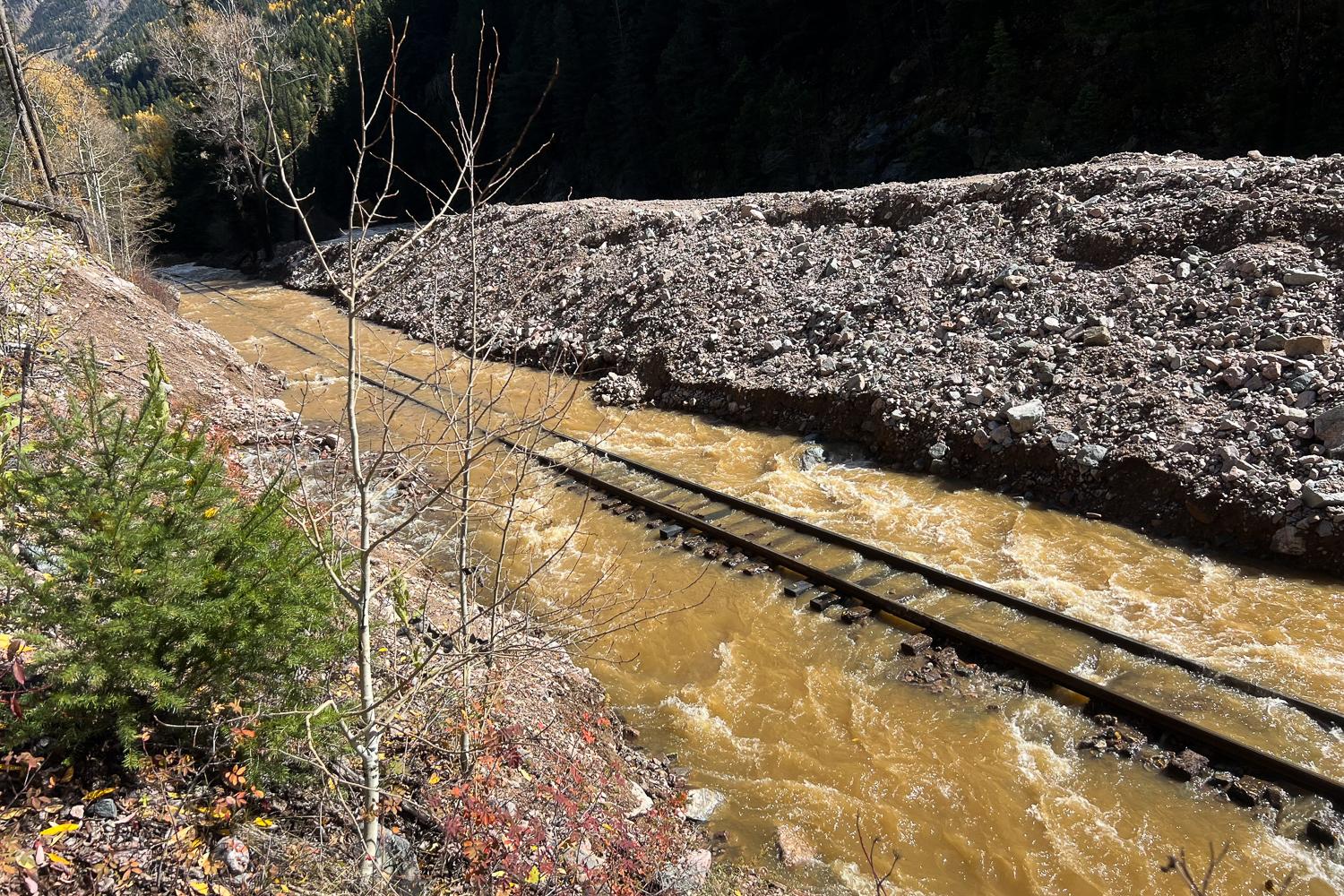
A $99 million plan to buy and permanently preserve some of the oldest water rights in Colorado is inching closer to securing all of its funding. But President-elect Donald Trump’s promise to gut climate spending could throw a wrench in the deal, despite its bipartisan support.
The Colorado River District, which advocates on behalf of Western Slope water users, submitted a funding application today to the U.S. Bureau of Reclamation under a program for drought mitigation. The district is seeking $40 million from the federal agency to help purchase water rights from Xcel Energy, the state’s largest utility.
Xcel Energy owns and operates the aging Shoshone Hydroelectric Generating Plant, nestled on the Colorado River near Glenwood Canyon. The river water that cascades through the plant generates electricity and then continues downstream, where it’s been used for decades for agriculture, drinking water, recreation and a federal fish habitat restoration project.
But rockfalls and dramatic equipment failures have shuttered the plant for months at a time, limiting how much water flows into the river, which is shrinking from climate-fueled drought and overuse.

Without a permanent guarantee to keep that water flowing, Western Slope advocates fear that the economy and environmental health of the river will suffer when the power plant shuts down for good, or if the rights are auctioned off to someone else.
“When we’re looking at the level of risk, that is why we’re looking for permanent protections for these water rights,” said Amy Moyer, Director of Strategic Partnerships for the river district.
In December 2023, the river district and Xcel Energy signed a purchase and sale agreement, which allows the district to purchase the water rights for $99 million, and then lease them back to the utility so it can continue to generate hydropower at the Shoshone plant.
In the process, the river district and state regulators would add permanent environmental protections to the Shoshone water rights — known as an “instream flow right" — so that a certain amount of water flows into the Colorado River permanently.
The river district hopes the sale, and all the regulatory hurdles, are cleared by December 2027.
Since the agreement, around 25 Western Slope water providers, the river district and the state of Colorado have committed $56 million to purchase the water rights. The state’s water conservation board, much of Colorado’s congressional delegation, and a bipartisan group of state lawmakers support the plan.
To make up the remaining funds, the river district is banking on money from the Inflation Reduction Act, the nation’s largest climate law, which was signed by Biden in 2022. Bureau of Reclamation records show the agency has $450 million remaining under the law to dole out to state, local and tribal governments in the upper Colorado River Basin for projects that offset the effects of drought and climate change.

Funding stream in question
That stream of federal funding for the Shoshone water deal has not yet been committed and could be in jeopardy, according to Martin Lockman, a law fellow at the Sabin Center for Climate Change Law. President-elect Trump said he would rescind any remaining funds from the inflation law when he returns to office. Project 2025, a conservative policy blueprint influential among the president-elect’s advisors, has called for repealing elements of the law.
The river district’s application comes at a time of great uncertainty for the future management of the Colorado River. This week, the federal government released five potential alternatives for how the river would be managed after 2026, which may cut how much water Colorado can use. The entire West is in a record mega-drought.
The Bureau of Reclamation is not expected to award its grants until spring 2025. Still, Colorado state lawmakers and the district are hopeful their project will receive funding.
“Even if the Trump administration looks at this, they’ll see this is a nonpartisan issue,” said State Sen. Dylan Roberts, D-Frisco, who supports the deal. “Securing the Colorado River and its flows is good for the country, whether you’re a Democrat or Republican, whether you supported Donald Trump or not.”

Western Colorado’s decades-long quest for water security
Water rights in the West are governed by a system known as “prior appropriation” that gives older water rights first priority for water during times of drought or scarcity.
Two water rights, from 1902 and 1929, enable over 332 billion gallons to flow through the Shoshone plant every year, if it’s continuously operating at full capacity.
Those rights are some of the oldest of their type on the main stem of the Colorado River. Crucially, they are also older than the rights that supply most of the water to the Front Range. That means when the plant “calls” for water, it trumps many other rights-holders in the state.
Securing the Shoshone water rights has been a decades-long dream of Western Slope water planners to guarantee the economic and ecological benefits the water provides. The water rights will be used to shore up river flows during drought years, preserve the habitat of endangered fish, and provide water for Western slope communities, according to the river district.
“It’s something that the West Slope has sought for a long time, for generations,” said Eric Kuhn, the former general manager of the river district.
Making that dream materialize involved intricate negotiations with Front Range water providers, who have also been eyeing the Shoshone rights and are now competing for the same water in an increasingly drought-prone Colorado.
In 2013, Western Slope providers and Denver Water negotiated the Colorado River Cooperative Agreement. For Denver Water, the agreement guaranteed that Western Slope water providers would not oppose permits to expand Gross Reservoir. The water utility is banking on the project to store more water for the Front Range, although a federal judge complicated that project last month.
In exchange, Denver Water dropped an equal right to buy the Shoshone plant from Xcel Energy, among other provisions.

In 2016, Western Slope and Front Range water providers agreed to the Shoshone Outage Protocol, which detailed how much water could flow into the Colorado River even when the plant was offline. But that agreement expires after 40 years and can be terminated at any time, according to the river district.
“We wanted a shorter term agreement that would preserve the call to the extent we could,” Kuhn said. “It’s a bridge is the way I see it, to a permanent instream flow right.”
The Colorado Water Conservation Board, a state agency, is the only entity that can hold an instream flow right to safeguard the health of rivers and their ecosystems.
Under the proposed deal, the river district would seek sign-off from the state to develop an instream flow agreement. That way, when the power plant is not operating, a set amount of water would still flow into the Colorado River.
“If you convert it to an instream flow, the benefits of the plant are there, whether the plant is operating or not. That’s the bottom line,” Kuhn said.
Colorado has facilitated dozens of similar water agreements, but none this large according to Rob Viehl, the head of stream and lake protection for the state.
If the state signs off, then the river district would have to plead its case in what’s known as “water court” to determine just how much water can flow into the river. The court bases that number on how much water has been historically used by an entity.
The historical use number has been subject to a sharp-elbowed debate by Northern Water, a Front Range water utility that supplies eight counties and cities like Fort Collins, Boulder and Greeley.
In its application, consultants for the river district evaluated data from when the plant was fully operational from 1975-2003, which estimated the average annual water drawn from the Shoshone rights at about 845,000 acre-feet.
In a September letter, Northern Water said its own analysis — which included data through 2023 — found that when the plant is offline, only a fraction of the water rights flow downstream.
Northern Water declined to comment on the district’s application.
Uncommitted federal funding could be undone
Roughly 40 percent of the Shoshone purchase is relying on federal funds from the Inflation Reduction Act, which contains $4 billion for water conservation and drought mitigation in areas including the Colorado River Basin.
Only an act of Congress can withhold money that’s already been appropriated to be spent under the climate law, according to Martin Lockman, of the Sabin Center. But President-elect Trump has maintained he has the constitutional ability to withhold the law’s funds. In 2019, the U.S. House of Representatives impeached Trump in part for withholding military aid to Ukraine.
The Trump administration could delay spending money that has not been formally committed to states, tribes or private companies. Much of the money under the law has to be spent by 2031.
“If that money has not been fully committed, if applications haven’t been fully reviewed, the incoming Trump administration would have a lot of ability to slow down that process, and generally kick up its heels,” Lockman said. “Programs that have not yet been distilled to a binding legal agreement are fairly vulnerable in this change of administration.”
The Trump administration could also “reprogram” up to 10 percent of remaining funding in any of the law’s programs, and spend it on something else.
The river district said it has backup plans in place if the funding is cut, but would not say what they were. State Sen. Roberts said he thinks the state would be open to providing more cash from a recently passed ballot initiative, which uses sports gambling money to fund water projects.
Republican U.S. Rep. Lauren Boebert and U.S. Sen. John Hickenlooper, who have supported the water deal, did not respond to CPR News’ request for comment about whether federal funding could be clawed back by the incoming Trump administration.
Bureau of Reclamation officials also declined to comment on whether it would award funding under the drought program before the next administration, only that it would begin reviewing applications immediately, according to a spokesperson.
“I think the folks at the Department of Interior are going to be burning the midnight oil,” Lockman said.
- How a second Trump administration might reverse drilling and energy restrictions on public lands in Colorado
- Evaporation is a big deal in the arid West. Scientists say we should stop measuring it like the 1950s
- Xcel Energy’s plan to replace state’s biggest coal plant could start with renewables and gas — and maybe end with nuclear









